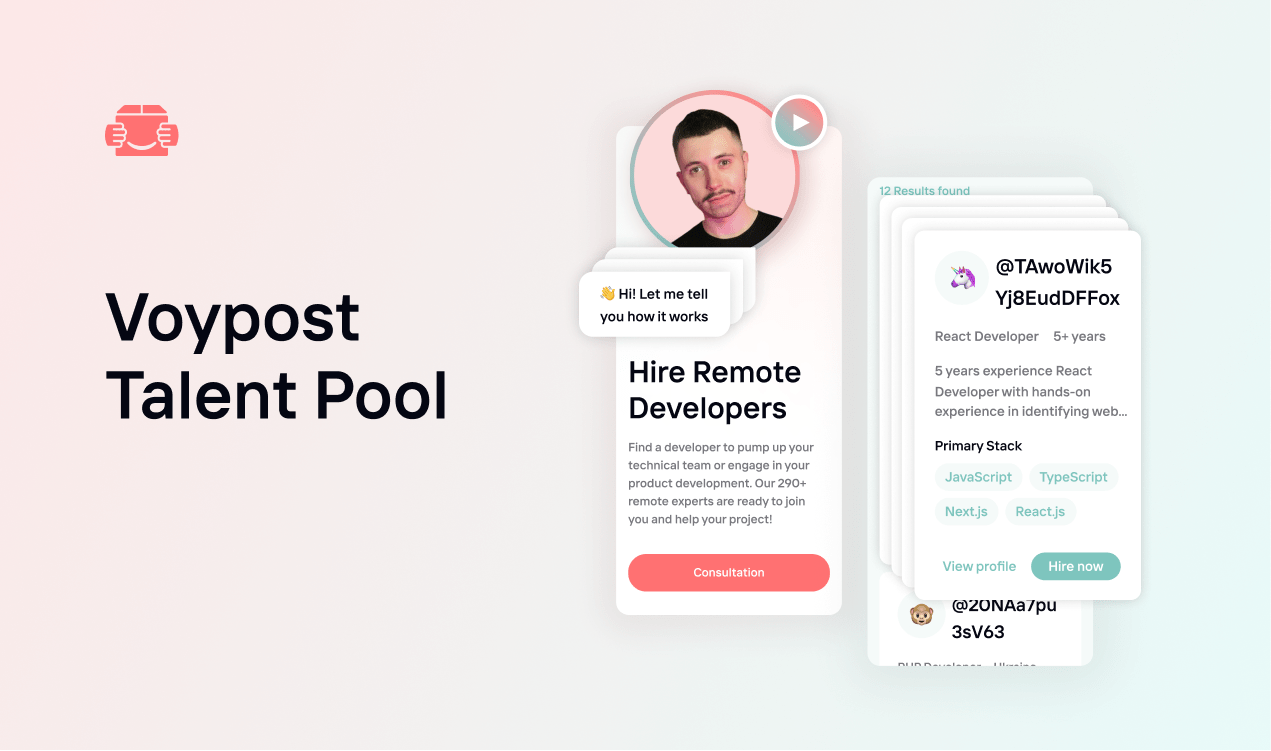Outstaffing vs Outsourcing: which to choose?
Software Outstaffing vs Outsourcing : and what could this choice mean for your business?
August 03, 2023
6 min read

Finding Right Talents for Your Product
To turn a great idea into a working digital product, you need the right people on your team. Qualified candidates in IT are not very easy to find and, if found, to keep on your team. Instead of building an expensive in-house team, many companies opt to outsourcing and outstaffing (IT staff augmentation).
According to Grand View Research, Inc, the global expenditures for outsourcing and outstaffing will reach $936.6 billion by 2027, then growing by 7.7% yearly. Resorting to external vendors is a real world-wide trend that has become the new norm in the IT industry.
Why do companies look for talent outside their own organizations? Main reasons are expense of hiring and maintaining permanent staff, conjugated with a shortage of qualified workers. Turning to IT staffing services allows employers to tap into whole new talent pools. Firstly, eliminating geographical borders means you can hire the best talent for your specific task from any country. Moreover, this working model is also more cost-effective, as companies determine salaries by baselines local to workers. As a result, paying for a talent from a lower cost country such as Ukraine can be as much as 50% less than for a similar talent from the United States
So, we have established that turning to the external vendor may be very beneficial to your company. The next question is, outstaffing or outsourcing? What is the difference? How to determine which suits your needs better: outsource or outstaff?
While the two models seem similar on the surface, let’s define what sets them apart.
The Power of Outstaffing
Basically, outstaffing in IT involves hiring remote professionals from external service providers to handle specific tasks or projects. To cover all the essential points about outstaffing, we’ve chosen the Q&A format for this article. Our expert guide will be Maria Shapovalova – Head of Growth at Voypost who’s answered frequently asked questions to ensure a clear and comprehensive understanding of outstaffing and its benefits.
What is outstaffing?
Outstaffing is when a company hires remote IT professionals or teams from an external service provider to work on specific projects or tasks. Instead of hiring new employees or expanding their in-house IT department, companies can tap into the expertise and skills of external IT specialists on a flexible basis.
Which type of projects does this hiring model work best for?
Outstaffing works well for startups that often face challenges in finding developers willing to work for them due to short-term employment and limited funds. However, it is not limited to startups; it is suitable for Small-to-Medium Enterprises and large companies as well. The outstaffing arrangement can be short-term or long-term, depending on the project's needs. Remote IT professionals work from their own location but become an integral part of the client's team, collaborating closely with the in-house staff. It's important to understand that outstaffing is different from IT outsourcing. In outsourcing, a company contracts an external service provider to handle the entire IT project or a significant portion of it, while in outstaffing, the hired professionals become an extension of the client's team and work under the client's direction.
What are the main advantages of outstaffing compared to hiring in-house?
Outstaffing offers several advantages. Firstly, it provides access to a broader talent pool of IT professionals with specialized skills that might not be locally available or could be more expensive to hire. It also saves on recruitment and onboarding costs associated with hiring full-time employees. Additionally, it allows you to quickly scale your IT team and adjust resources based on project requirements, offering flexibility and cost-efficiency.
Moreover, outstaffing can save a significant amount of your budget. For many startups, budget is the primary driver of staffing model decisions. Outstaffing doesn’t limit startups to a certain location, allowing them to reach offshore talent. For example, developers for startups from Ukraine can save up to 40% of a budget compared to developers of equal expertise in Western Europe or USA. In addition, you can reduce the budget by eliminating additional costs associated with hiring in-house staff - workplace organization, health insurance costs, and tax payments.
Outstaffing model enables easy maintenance, especially for startups with short-term development needs, allowing you to scale your team as required. In many countries, there are strict employment laws: paid vacations, taxes, paid sick leaves etc. The specificity of startups is a short-term need for a development company - from 3 to 12 months. Few people want to join in-house teams, knowing they’ll be fired after the development phase is over. Outstaffing allows scaling easily and getting developers for any term.
Can you give us examples of outstaffing vendors in the IT industry?
There are many outstaffing platforms with rigorous screening processes to ensure competent and vetted programmers. One such platform is Voypost, (which blog are you currently reading :), which grants access to the top 5% of remote developers worldwide. Voypost sets multiple stages of recruitment, including interviews, test assignments, and technical assessments to evaluate coding skills. We even verify developers' competency in real conditions through test projects.

How are outstaffing platforms like Voypost arranged?
At Voypost, we offer you to find and hire developers within 3 to 14 days using our specialized tool called Talent Pool. We maintain a talent pool of pre-screened and vetted developers with over 60 tested skills, including data structures, algorithms, software specializations, and more. With our advanced search filters, you get access to over 50 parameters, including tech stack, years of experience, preferred industries, and types of IT projects, to help you find the perfect candidate. So why settle for anything less than the best? You can say goodbye to scrolling through countless resumes and hello to your dream developer.
How does the hiring process work on platforms like Voypost?
In a nutshell, we can point out the following process:
1. Review developers profiles
2. Conduct an interview with the selected talent
3. Choose the best one
As you can see, the hiring process with Voypost is simple. After reviewing developer profiles, you select the ones that interest you. Then,you conduct interviews with the selected talent to assess their fit for your project. Once you've made your choice, you initiate the hiring process through Voypost's platform. An Engagement Manager from Voypost will contact you to discuss project details and schedule an interview with your chosen developer. After finalizing the details, you sign the contract and provide the developer with the necessary tools and resources to begin working.

Ready to scale your business using outstaffing services?
Embrace the advantages and opportunities it offers in today's competitive market. Take the first step towards success by choosing the right outstaffing partner for your specific needs. Contact us now to embark on a journey of growth and efficiency.
What is Outsourcing?
Outsourcing literally means a company gives their idea to a remote development team — and they deliver a final digital product. While an outsource vendor provides their technical and management expertise, the company can focus on its business. The concept behind is to reduce costs and a way to use someone else’s highly-specialised expertise and experience.
Which Type of Projects does Outsourcing Work Best for?
Outsourcing works exceptionally well for projects that require a whole team of developers and project managers to bring the client's vision to life. When a project demands a comprehensive set of skills, expertise, and resources, outsourcing can be the ideal solution to assemble a dedicated team tailored to the project's specific requirements.
Advantages of Outsourcing Compared to Hiring In-House
Outsourcing offers several compelling advantages over hiring an in-house team for specific tasks or projects. Firstly, it provides significant cost savings as companies can pay for services on a project basis or a fixed rate, eliminating the need for long-term commitments and associated overhead costs. Moreover, outsourcing grants access to a diverse talent pool with specialized skills that may not be available locally. This helps companies collaborate with experts in various fields without the need for extensive training or upskilling of their in-house staff.
In addition, outsourcing allows businesses to focus on their core competencies and strategic initiatives by delegating non-core functions to external providers. This enhances overall efficiency and productivity. Additionally, it offers scalability and flexibility, enabling companies to quickly adjust their operations without the limitations of hiring, training, and onboarding new employees. They can easily adapt to project requirements and market demands.
Furthermore, outsourcing contributes to improved time management by freeing up valuable time for the company's internal team to concentrate on critical tasks and projects, leading to enhanced project completion and delivery timelines. Lastly, it provides companies with the opportunity to tap into global markets by collaborating with service providers from different countries, broadening their reach and gaining valuable insights into international markets.

Get a Consultation on Hiring Developers
Get a consultation on hiring developers for startup projects. Our expertise and professionalism will help you quickly create a dream team for the development of any IT product
Outsourcing vs Outstaffing: Conclusion
An outsourcing company will be fully accountable for work results and quality. They decide on the framework and team composition, controlling the development process from A to Z. On the other hand, an outstaffing team provider does not intrude into the company’s software engineer work and an in-house project manager will always oversee what they do and communicate with them.
Which one you need therefore depends on whether you have an in-house team and what kind of expertise you require. If you are not 100% sure about your ability to outsource or outstaff, Voypost can help you choose and build a dream team for your business needs specifically. We provide both outsourcing and outstaffing services and have extensive commutative experience in a wide variety of specialties in all areas of digital product development.
We would love to hear about your needs and put together the most suitable solutions for you. Happy Outstaffing & Outsoursing!